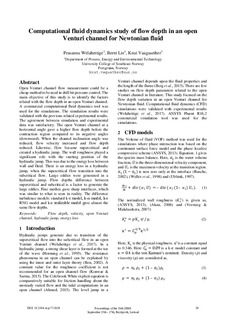Computational fluid dynamics study of flow depth in an open Venturi channel for Newtonian fluid
Journal article, Peer reviewed
Published version
Permanent lenke
http://hdl.handle.net/11250/2459904Utgivelsesdato
2017Metadata
Vis full innførselSamlinger
Sammendrag
Open Venturi channel flow measurement could be a cheap method to be used in drill bit pressure control. The main objective of this study is to identify the factors related with the flow depth in an open Venturi channel. A commercial computational fluid dynamics tool was used for the simulations. The simulation results were validated with the previous related experimental results. The agreement between simulation and experimental data was satisfactory. The open Venturi channel at a horizontal angle gave a higher flow depth before the contraction region compared to its negative angles (downward). When the channel inclination angle was reduced, flow velocity increased and flow depth reduced. Likewise, flow became supercritical and created a hydraulic jump. The wall roughness played a significant role with the starting position of the hydraulic jump. This was due to the energy loss between wall and fluid. There is an energy loss in a hydraulic jump, when the supercritical flow transition into the subcritical flow. Large eddies were generated in a hydraulic jump. Flow depths difference between supercritical and subcritical is a factor to generate the large eddies. Fine meshes gave sharp interfaces, which was similar to what is seen in reality. The difference turbulence models: standard k-e model, k-? model, k-e RNG model and k-e realizable model gave almost the same flow depths. Open Venturi channel flow measurement could be a cheap method to be used in drill bit pressure control. The main objective of this study is to identify the factors related with the flow depth in an open Venturi channel. A commercial computational fluid dynamics tool was used for the simulations. The simulation results were validated with the previous related experimental results. The agreement between simulation and experimental data was satisfactory. The open Venturi channel at a horizontal angle gave a higher flow depth before the contraction region compared to its negative angles (downward). When the channel inclination angle was reduced, flow velocity increased and flow depth reduced. Likewise, flow became supercritical and created a hydraulic jump. The wall roughness played a significant role with the starting position of the hydraulic jump. This was due to the energy loss between wall and fluid. There is an energy loss in a hydraulic jump, when the supercritical flow transition into the subcritical flow. Large eddies were generated in a hydraulic jump. Flow depths difference between supercritical and subcritical is a factor to generate the large eddies. Fine meshes gave sharp interfaces, which was similar to what is seen in reality. The difference turbulence models: standard k-e model, k-? model, k-e RNG model and k-e realizable model gave almost the same flow depths.

